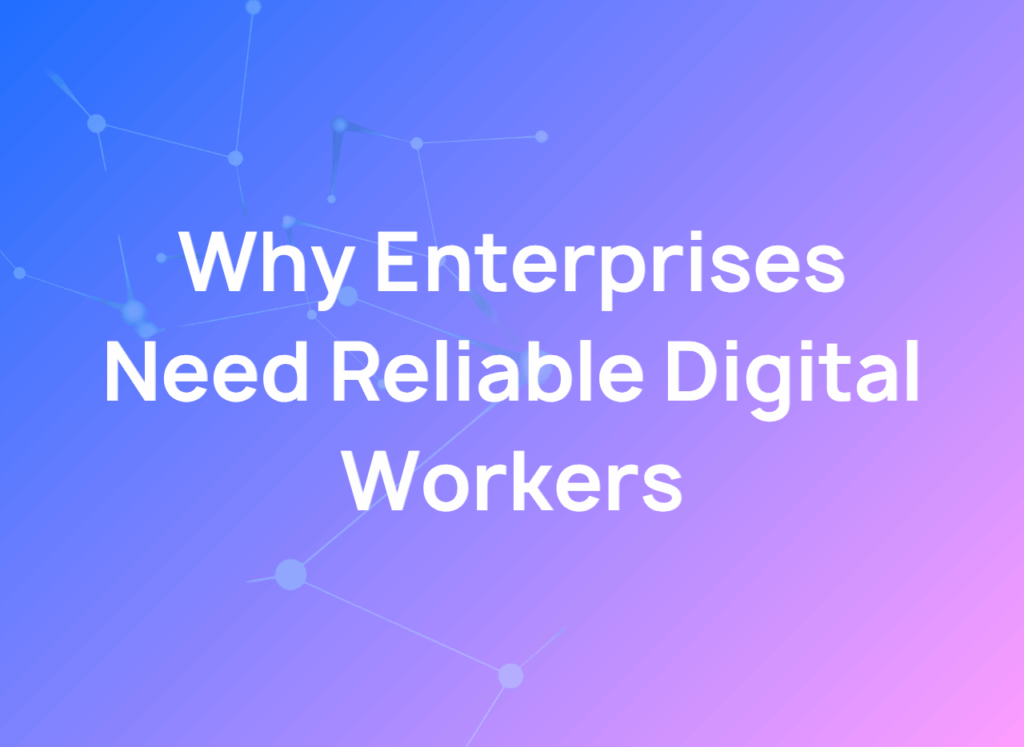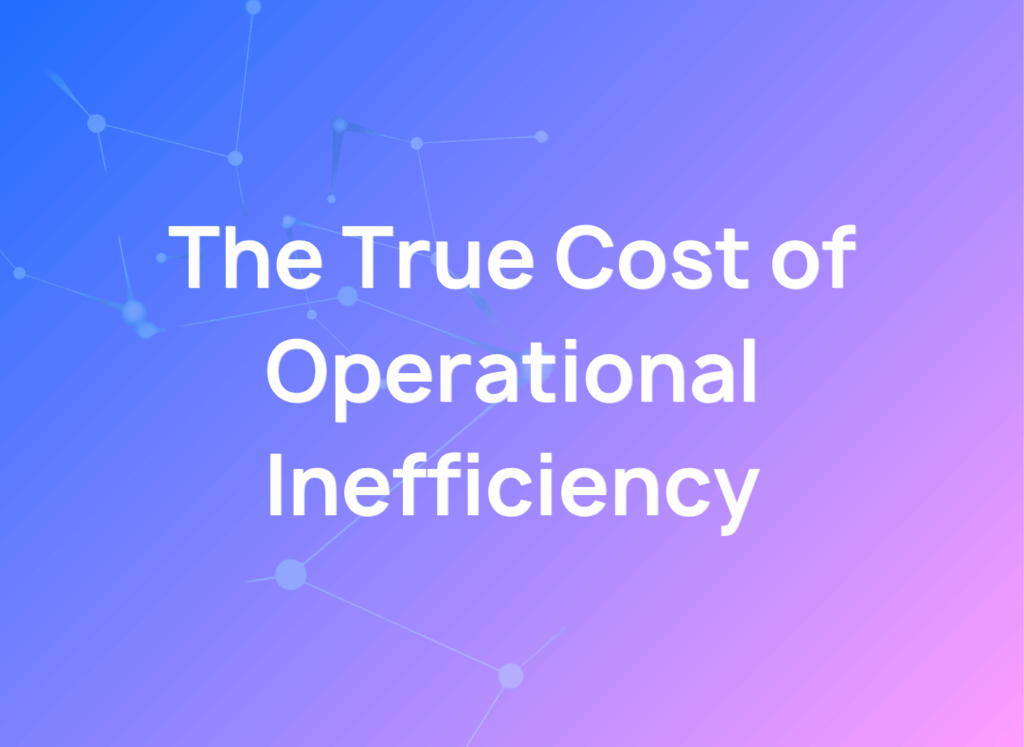Creating Digital Labour: The New Operating Model for Work
Creating Digital Labour: The New Operating Model for Work
The future of work isn't about hiring more people or buying more software. It's about deploying Digital Workers—AI-powered systems that execute entire workflows autonomously, transforming how enterprises achieve their strategic objectives.
With 10 trillion hours of human labor being reshaped globally, we're witnessing the collapse of outdated operational models. Billions of dollars invested in fragmented software ecosystems and consultancy-dependent processes are becoming obsolete. The enterprises that recognize this shift now will lead their industries tomorrow.
Digital Labour represents a fundamental paradigm shift. Instead of layering more tools onto existing inefficiencies, forward-thinking organizations are building custom Digital Workers that replace clunky, one-size-fits-all solutions with seamless, high-performance systems designed for their unique operational requirements.
This transformation extends far beyond simple automation. We're witnessing the emergence of a new cost structure for business operations—one where scaling doesn't require proportional increases in headcount, software licenses, or consulting fees. The ripple effects are reshaping entire industries, and the enterprises embracing this change are unlocking efficiency and innovation at unprecedented scale.
The Enterprise Awakening: From Tools to Outcomes
Enterprise leaders face mounting frustration with the traditional software procurement model. The average CRM implementation takes 6-18 months, costs millions, and delivers rigid systems that constrain rather than enable business growth. The global CRM implementation market, worth tens of billions annually, has become synonymous with lengthy setup times, inflexible workflows, and disappointing outcomes.
This dissatisfaction signals a fundamental shift in enterprise expectations. Organizations no longer want to purchase software—they want to buy results. They're demanding systems that adapt to their unique operational requirements rather than forcing their teams to conform to generic workflows built by human specialists who lack intimate knowledge of their business.
The market is pivoting toward outcome-driven systems that prioritize seamless production over feature lists. Digital Workers embody this transformation by focusing exclusively on delivering specific business outcomes. Instead of asking teams to learn new interfaces, Digital Workers integrate directly into existing workflows, executing tasks as instructed through natural language commands.
This shift represents more than technological evolution—it's operational revolution. Enterprises are realizing they don't need another dashboard to monitor; they need intelligent systems that take action. They don't want reports about problems; they want systems that solve problems autonomously.
The Decline of Static SaaS Interfaces
Traditional SaaS platforms, with their fancy user interfaces layered over static databases, are becoming obsolete. These systems force users into predetermined workflows, require extensive training, and become bottlenecks rather than accelerators for business operations.
Digital Workers redefine this paradigm through dynamic, context-aware operation. Unlike traditional software that presents the same interface to every user, Digital Workers generate insights and interfaces on-demand, adapting in real-time to specific operational needs rather than displaying pre-configured dashboards.
The transformation is most evident in workflow management. Traditional SaaS tools offer either rigid, pre-built workflows or complex no-code builders that require significant time investment. Digital Workers eliminate this constraint by integrating directly with existing data sources and executing tasks through conversational instructions, making complex operations as simple as sending a message to a colleague.
Consider the contrast: a traditional analytics platform requires users to navigate through multiple screens, configure reports, and wait for batch processing. A Digital Worker receives a natural language request, accesses relevant data sources, performs the analysis, identifies insights, and delivers actionable recommendations—all within minutes rather than hours.
This fundamental shift from static interfaces to dynamic execution represents the future of enterprise software. Organizations no longer need to train employees on new tools; instead, they deploy Digital Workers that understand business context and execute tasks autonomously.
The Smart Evolution: Dashboards and Workflows Reimagined
While traditional dashboards and workflows face obsolescence, their core functions remain essential for repetitive processes and consistent insights. The transformation lies not in eliminating these elements but in making them smarter, faster, and dramatically more cost-effective.
Agentic systems revolutionize dashboard creation by building them dynamically based on specific business needs rather than generic templates. This approach delivers cost-effective solutions that can be developed and deployed in days rather than months, at a fraction of traditional development costs.
The flexibility extends to personalization at scale. Unlike static dashboards that display the same information to every user, intelligent systems create personalized views based on role, department, and specific objectives. This personalization happens automatically, without requiring manual configuration or IT intervention.
A compelling example emerged recently when a DocuSign alternative was built using modern development platforms in just two days. While the solution wasn't perfect, it demonstrated a critical trend: the speed and cost advantages of intelligent system development are accelerating rapidly. What once required months of development and hundreds of thousands in investment can now be achieved in days for a fraction of the cost.
This trend signals broader transformation across enterprise software. Organizations are discovering they can build custom solutions faster and cheaper than implementing off-the-shelf alternatives. The implications extend beyond cost savings—custom-built Digital Workers integrate seamlessly with existing systems, require no user training, and evolve continuously based on actual business needs.
The future belongs to organizations that embrace this model: deploying purpose-built Digital Workers rather than forcing their operations into rigid, generic software frameworks.
Transforming the Work Layer: Beyond Systems of Record
Traditional systems of record—ERP platforms, CRMs, and data warehouses—once served as the central nervous system of business operations. Today, they're evolving into glorified databases as the actual work layer shifts beyond their boundaries. The real operational value now occurs in the space between systems, where Digital Workers orchestrate complex workflows across multiple platforms.
This transformation represents a fundamental shift in enterprise architecture. Instead of confining work within siloed systems, organizations are deploying Digital Workers that operate at the system-of-work level, integrating data and processes across the entire technology stack.
The impact becomes clear in data migration projects, traditionally among the most time-intensive and error-prone initiatives in enterprise operations. Digital Workers are completing these projects 90-95% faster than traditional human-led or consultancy-driven methods, transforming months-long engagements into week-long implementations.
This acceleration stems from Digital Workers' ability to understand both source and destination systems simultaneously, identify data inconsistencies in real-time, and execute transformations without the iterative back-and-forth that characterizes human-led projects. They operate continuously, don't require meetings or status updates, and maintain perfect consistency throughout the migration process.
The broader implication extends far beyond data migration. Digital Workers are transforming financial reporting, customer onboarding, inventory management, and strategic analysis. They're eliminating the handoffs between systems that create delays and errors in traditional workflows.
Organizations embracing this model are reducing their reliance on costly, time-intensive consulting engagements while gaining unprecedented visibility and control over their operations. They're discovering that work doesn't need to happen inside systems—it can happen intelligently across systems, orchestrated by Digital Workers that understand business objectives rather than just technical specifications.
From Insights to Autonomous Action
The most transformative aspect of Digital Labour lies not in generating better reports or faster insights, but in autonomous execution. Digital Workers don't just identify problems—they solve them within predefined operational constraints.
This capability represents a quantum leap beyond traditional analytics platforms that excel at diagnosis but require human intervention for treatment. Digital Workers equipped with appropriate tools can identify inefficiencies, predict potential issues, and take corrective action automatically, transforming reactive operations into proactive systems.
Consider inventory management: traditional systems alert managers when stock levels drop below thresholds. Digital Workers identify trends that predict stock shortages, automatically adjust reorder points based on seasonal patterns, coordinate with suppliers to expedite deliveries, and update financial forecasts to reflect inventory investments—all without human intervention.
The shift from passive observation to proactive execution is redefining enterprise efficiency across all operational areas. In customer service, Digital Workers identify satisfaction trends, proactively reach out to at-risk customers, coordinate with relevant departments to address concerns, and implement process improvements based on interaction patterns.
Financial operations see similar transformation. Instead of generating month-end reports that identify budget variances after they occur, Digital Workers monitor spending patterns in real-time, flag potential overruns before they happen, automatically reallocate resources within approved parameters, and provide recommendations for strategic adjustments.
This autonomous execution capability transforms the fundamental economics of business operations. Organizations can maintain 24/7 operational vigilance without proportional increases in staffing costs. They can respond to opportunities and threats at machine speed rather than meeting cadence.
The Economic Revolution: Redefining Operational Costs
Digital Labour fundamentally transforms enterprise cost structures by eliminating the traditional trade-offs between quality, speed, and expense. Organizations deploying Digital Workers report ROI figures exceeding 500%, achieved through three primary mechanisms: consolidated software spend, avoided hiring costs, and eliminated consulting dependencies.
Software consolidation represents the most immediate impact. Instead of licensing multiple point solutions—each requiring separate training, maintenance, and integration efforts—organizations deploy Digital Workers that accomplish the same objectives through intelligent orchestration of existing systems. This consolidation typically reduces software expenses by 40-60% while improving operational outcomes.
Hiring avoidance delivers even greater long-term value. Traditional operational scaling requires proportional workforce expansion, creating ongoing salary, benefit, and overhead costs. Digital Workers handle increasing operational complexity without additional personnel, allowing organizations to achieve aggressive growth targets while maintaining lean operational structures.
The elimination of consulting dependencies provides the most dramatic savings. Large enterprises routinely spend millions annually on consultancy engagements for process optimization, system integration, and analytical projects. Digital Workers execute these same initiatives continuously, at a fraction of the cost, without the knowledge transfer challenges that characterize consulting relationships.
Organizations implementing Digital Labour often discover they can operate more efficiently with smaller teams than they previously managed with larger ones. This isn't about workforce reduction—it's about workforce elevation. Teams freed from repetitive operational tasks focus on strategic initiatives that drive genuine competitive advantage.
The economic benefits extend beyond direct cost savings. Digital Workers operate consistently, don't require vacation coverage, and maintain institutional knowledge permanently. They scale instantly during peak periods and optimize resource utilization during slower cycles. This operational flexibility provides significant competitive advantages in dynamic market conditions.
Implementation Strategy: The Digital Labor Factory Approach
Successful Digital Labour implementation requires systematic methodology rather than ad-hoc automation efforts. The most effective organizations adopt a Digital Labor Factory approach—building repeatable blueprints that accelerate deployment while ensuring consistent quality and integration.
The factory model begins with foundational automation of high-effort, low-complexity tasks: data cleaning, report generation, invoice processing, and workflow coordination. These initial implementations demonstrate immediate value while building organizational confidence in autonomous operations.
Phase two focuses on complex analytical workflows that previously required specialized expertise: root cause analysis, demand forecasting, performance attribution, and strategic modeling. Digital Workers executing these functions operate continuously, providing up-to-date insights rather than periodic reports.
The final phase unlocks causal intelligence capabilities, where Digital Workers explain performance changes, simulate counterfactuals, and adapt to shifting business drivers automatically. This represents the full realization of AI potential—not just processing data, but understanding business context and optimizing outcomes proactively.
Organizations following this progression typically see immediate productivity gains in phase one, strategic capability enhancement in phase two, and competitive differentiation in phase three. The factory approach ensures each implementation builds upon previous successes while maintaining operational stability.
Critical success factors include executive sponsorship, clear success metrics, and gradual expansion rather than enterprise-wide transformation attempts. The most successful implementations start with willing departments that become internal advocates for broader adoption.
The Future of Enterprise Operations
Digital Labour represents more than operational improvement—it's the foundation of next-generation business models. Organizations mastering this transformation will compete with fundamentally different cost structures, response capabilities, and strategic agility than their traditionally-operated competitors.
The shift is already accelerating across industries. Financial services firms deploy Digital Workers for regulatory compliance, risk monitoring, and customer analysis. Manufacturing organizations use them for supply chain optimization, quality control, and predictive maintenance. Healthcare systems implement them for patient care coordination, resource allocation, and outcome analysis.
The common thread across successful implementations is focus on outcomes rather than technology. Organizations that view Digital Labour as a way to buy results rather than build systems consistently achieve superior implementation success and business impact.
The transformation extends beyond individual organizations. As Digital Labour adoption accelerates, industry-wide operational standards will evolve. Customer expectations for response times, service quality, and personalization will increase. Competitive advantage will increasingly depend on operational intelligence rather than just product features.
Organizations beginning this transformation today position themselves advantageously for the next decade of business competition. Those waiting for "perfect" solutions or industry-wide adoption risk being overwhelmed by competitors operating with fundamentally superior efficiency and agility.
Taking Action: Your Digital Labour Journey Begins Now
The window for competitive advantage through Digital Labour implementation is narrowing rapidly. Early adopters are already realizing substantial operational improvements while building capabilities that will define industry leadership over the next decade.
Your transformation begins with honest assessment of current operational inefficiencies. Identify the manual workflows that consume disproportionate time and resources. Map the handoffs between systems that create delays and errors. Calculate the true cost of consultancy dependencies and software sprawl.
The next step involves piloting Digital Worker deployment in specific operational areas where success can be measured clearly and quickly. Focus on outcomes that matter to your organization: faster decision-making, reduced operational costs, improved accuracy, or enhanced customer responsiveness.
Success requires partnership with organizations that understand both AI capabilities and enterprise operational realities. The most effective Digital Workers are custom-built rather than configured, designed specifically for your operational requirements rather than generic business processes.
The future belongs to organizations that embrace Digital Labour as a strategic advantage rather than viewing it as incremental automation. Your competitors are already exploring these capabilities. Your customers are beginning to expect the responsiveness and personalization that Digital Workers enable.
The transformation of work is accelerating. The question isn't whether Digital Labour will reshape your industry—it's whether you'll lead that transformation or be transformed by it.
Create your AI Workforce today
Lead the transformation in your industry.





